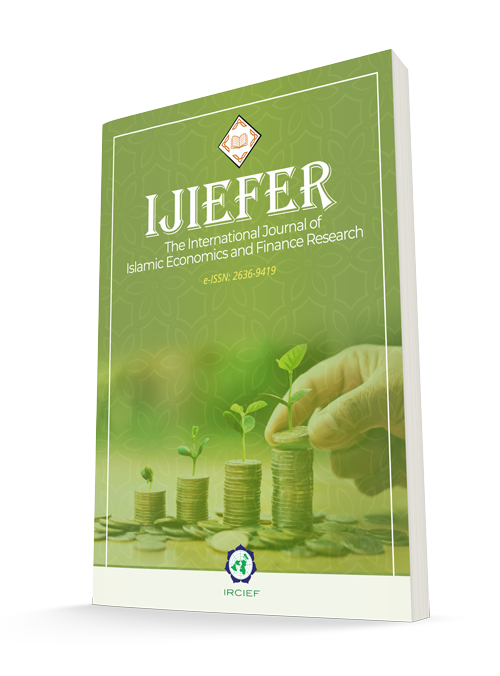CRITERIA OF POTENTIAL SHARIAH NON-COMPLIANCE EVENT: ANALYSIS IN A FULL-FLEDGED ISLAMIC BANK IN MALAYSIA
DOI:
https://doi.org/10.53840/ijiefer192Keywords:
Potential Shariah Non-Compliance Event, Shariah Non-Compliance Reporting, Shariah Control FunctionAbstract
Referring to the latest ORR policy document issued in 2023, Bank Negara Malaysia (BNM) has removed the requirement for a Potential Shariah Non-Compliance (SNC) to be confirmed by a “qualified Shariah officer” and replaced with the “officer within Shariah control function” which could include officers with and without the Shariah study background. This amendment raised questions on how the officer without the Shariah study background assessed and confirmed an event as a Potential SNC before escalating it to the Shariah Committee for confirmation. In general, Islamic banking is distinguished from conventional banking by its adherence to the principles of Shariah. As compared to its counterpart, Islamic banking is exposed to an additional risk peculiar to its operation: the SNC risk. Thus, proper management of SNC risk is vital for Islamic banking since the impact of the risk could not only possibly affect the financial but also the image it carries. One of the governance aspects in managing SNC risk is the capability of its officer to identify, assess, and report SNC incidents. In this regard, BNM through its Operational Risk Reporting (ORR) policy document, requires Potential SNC events and Actual SNC events to be reported to the BNM. This paper discusses the criteria for Potential SNC events as a guide to be used by officers within the Shariah control function. This research adopted a qualitative approach using interviews and comparative content analysis of the financial statements of one of the full-fledged Islamic banks in Malaysia as the methodology for data analysis.
Downloads
References
Al-Jarjani. (1983). Kitab Al-Ta’rifat (First). Dar Kutub Ilmiah.
Al-Jassas, A. ibn A. A. B. (1994). al-Fusul fi al-Usul (Second). Wizarat Al-Awqaf.
Al-Mausu’ah al-Fiqhiyyah. (1984). Wizarat al-Awqaf wa al-Shu’un al-Islamiyyah.
Al-Nawawi. (n.d.). Al-Majmu’ Syarh Al-Muhazzab (Vol. 12). Dar al-Fikr.
Al-Nawawi. (1972). Al-Minhaj bi Sharh Sahih Muslim (Second, Vol. 11). Dar Ihya’ al-Turath al-Arabi.
Al-Razi. (1997). al-Mahsool (Third, Vol. 1). Muassasah al-Risalah.
Al-Salmi, I. N. (2005). Usul Fiqh - La Yasa’u al-Faqih Jahluhu (First). Dar al-Tadmiriah.
Al-Sarkhasi, M. A. (1993). Al-Mabsut (Not stated). Dar al-Makrifah.
Al-Suyuti. (1983). Al-Ashbah wa Al-Nadhzoir (First). Dar Kutub Ilmiah.
Al-Taftazani, S. A. M. (n.d.). Syarah Talwih ’ala Tawdhih (Vol. 2). Maktabah Sobih.
Al-Zarkashi, B. A. M. ibn A. (1985). Al-Manthur fi al-Qawaid al Fiqhiah (Second, Vol. 2). al-Wizarah al-Awqaf.
Al-Zuhayli, W. (2009). Al-Muamalat al-Maliah al-Mu’asarah (Seventh). Dar al-Fikr.
BNM. (2018). Operational Risk Reporting Requirement - Operational Risk Integrated Online Network (ORION). Bank Negara Malaysia.
BNM. (2019). Shariah Governance Policy Document 2019. Bank Negara Malaysia.
BNM. (2023). Operational Risk Reporting (ORR). Bank Negara Malaysia.
Dusuki, A. W., Ali, M. M., & Hussain, L. (2012). A Framework for Islamic Financial Institutions to Deal with Shari’ah Non-compliant Transactions. ISRA Research Paper (NO. 42/2012).
Hakim, A. L. (2017). Application of Three Lines of defense in Islamic Financial Institution. International Journal Of Management and Applied Research, 4(1), 44–57. https://doi.org/10.18646/2056.41.17-005
Hasan, Z. (2010). Regulatory Framework of Shari’Ah Governance System in Malaysia, GCC Countries and the UK. Kyoto Bulletin of Islamic Area Studies, 3(2), 82–115. https://www.researchgate.net/publication/256043882
Ibn ’Abidin. (1966). Rad Al-Muhtar ’ala al-Dur Al-Mukhtar (Second, Vol. 2). Syirkah Maktabah wa Matba’ah Mustafa al-Babi al-Halbi.
Ibn Nujaim. (1999). Al-Ashbah wa Al-Nadhzoir (First). Dar Kutub Ilmiah.
Islam, M. R. (2022). Origin and Theoretical Development of Islamic Sharìah: An Overview. Rajshahi University Journal of Arts & Law, 50, 44–63.
Islamic Financial Service Board (IFSB). (2005). Guiding Principles of Risk Management for Institutions (Other Than Insurance Institutions) Offering Only Islamic Financial Services.Www.Ifsb.Org. https://www.ifsb.org/download.php?id=4357&lang=English&pg=/published.php
Jalil, A., Ramli, A. M., & Shahwan, S. (2014). The Four Introductory Theories of Fiqh Muamalat (First). Wisdom Publication.
Kusumaningtias, R. (2024). Impact and risk management of sharia non-compliance in Islamic banking (Vol. 2).
Lahsasna, A. (2014). Shariah Non-Compliance Risk Management and Legal Documentation in Islamic Finance. John Wiley & Sons Singapore Pte. Ltd.
Malaysia. (2013). Islamic Financial Services Act 2013.
Mohd Noor, N. S., Ismail, A. G., & Muhammad, M. H. (2018). Shariah Risk: Its Origin, Definition, and Application in Islamic Finance. SAGE Open, 8(2). https://doi.org/10.1177/2158244018770237
Omar, H. N., & Hassan, R. (2019). Shariah Non-Compliance Treatment in Malaysian Islamic Banks. International Journal of Management and Applied Research, 6(4), 220–233. https://doi.org/10.18646/2056.64.19-016
Omar, H. N., & Hassan, R. (2020). Challenges Faced by Malaysian Islamic Banks in Treating Shariah Non-compliance Events. 7th ASEAN Universities International Conference on Islamic Finance (7th AICIF2019) - Revival of Islamic Social Finance to Strengthen Economic Development Towards a Global Industrial Revolution, 256–264. https://doi.org/10.5220/0010145102560264
Downloads
Published
How to Cite
Issue
Section
License
Copyright (c) 2025 IJIEFER

This work is licensed under a Creative Commons Attribution-NonCommercial 4.0 International License.










